Iconography is the study of imagery and themes in art and culture‚ analyzing symbols‚ meanings‚ and historical contexts across various media. It combines art history‚ theology‚ and cultural studies to interpret visual representations‚ offering insights into societal values and beliefs. This interdisciplinary approach examines motifs‚ styles‚ and their evolution over time‚ providing a framework for understanding artistic and cultural expressions.
1.1 Definition and Scope
Iconography‚ a modern approach to analyzing ancient and historical art‚ focuses on identifying‚ classifying‚ and interpreting themes‚ motifs‚ and symbols in visual works. It examines the imagery’s meaning within cultural‚ religious‚ and historical contexts‚ offering insights into societal values and beliefs. The scope extends across various disciplines‚ including art history‚ theology‚ and cultural studies‚ providing a comprehensive framework for understanding visual representations. By studying iconography‚ scholars uncover the deeper significance of artistic expressions‚ linking them to broader cultural and historical narratives. This interdisciplinary approach bridges the gap between visual and textual analysis‚ enriching our understanding of art’s role in reflecting and shaping human experiences.
1.2 Historical Context
Iconography has deep historical roots‚ evolving from ancient civilizations to modern times. In early periods‚ it served religious and symbolic functions‚ as seen in Byzantine art and Buddhist deities. The study gained prominence during the Renaissance‚ focusing on theological themes and cultural motifs. Historically‚ iconography was integral to art’s purpose‚ often reflecting societal values and beliefs. Over time‚ its application expanded into diverse fields‚ including cartography and funerary art. The historical context of iconography highlights its adaptability and enduring relevance‚ making it a vital tool for understanding artistic and cultural developments across eras.

Historical Development of Iconography
Iconography evolved from ancient symbolism to intricate representations‚ transitioning through medieval‚ Renaissance‚ and modern periods‚ reflecting cultural and religious shifts while maintaining its core role in visual storytelling.
2.1 Ancient Periods
Ancient iconography laid the groundwork for understanding visual symbolism across cultures. Egyptian art‚ for instance‚ heavily relied on symbolic representations of deities and mythological scenes‚ which were often tied to religious and cosmic beliefs. Similarly‚ Buddhist iconography emphasized spiritual themes‚ using imagery like the lotus flower and wheel of dharma to convey enlightenment. The identification of Egyptian Seth with Asiatic storm-gods highlights cross-cultural influences in early iconographic developments. These ancient systems of visual storytelling not only reflected societal values but also served as tools for religious and cultural transmission. Studying these early examples provides insights into the evolution of symbolic communication and its enduring impact on art and culture.
2.2 Medieval Iconography
Medieval iconography flourished as a powerful tool for religious and cultural expression‚ particularly in Byzantine and European traditions. Byzantine art‚ for example‚ emphasized theological themes‚ using imagery to convey divine messages and elevate spiritual understanding. Religious symbols‚ such as the crucifixion and depictions of saints‚ dominated this period‚ often blending theology with artistic representation. Scholars like Gérard Colas have explored how these visual narratives reflected societal values and religious ideologies. The use of gold leaf and mosaics in Byzantine iconography underscored the sacred nature of the imagery. This period also saw the rise of illuminated manuscripts‚ further integrating iconography into daily religious practices. Medieval iconography remains a cornerstone of art historical study‚ offering insights into the intersection of faith‚ culture‚ and visual representation.
2.3 Renaissance and Beyond
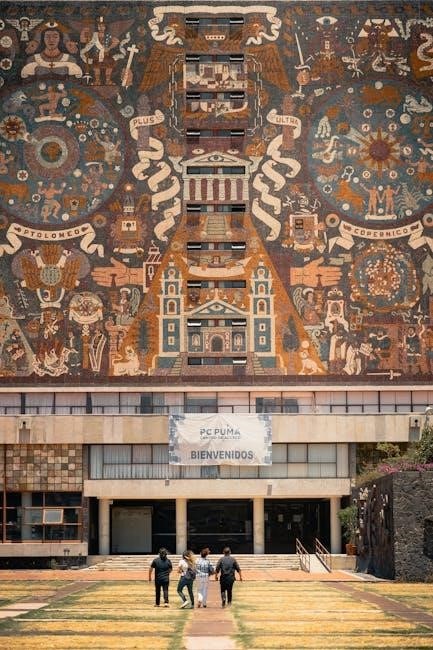
The Renaissance marked a transformative period for iconography‚ blending classical themes with religious motifs. Artists like Michelangelo and Raphael incorporated symbolic imagery‚ drawing from mythology and theology. This era saw a shift from purely religious iconography to more secular and humanist themes‚ reflecting the cultural and intellectual changes of the time. Iconography became a tool for storytelling‚ with symbols conveying complex meanings. Beyond the Renaissance‚ iconography continued to evolve‚ influencing Baroque art’s dramatic compositions and later‚ the rise of political iconography‚ such as Lenin’s imagery in the USSR. This period highlighted iconography’s adaptability to cultural and political contexts‚ expanding its role in visual communication and historical narratives.

Role of Iconography in Various Fields
Iconography plays a crucial role in art history‚ theology‚ and cultural studies‚ analyzing symbols and themes to understand cultural values‚ religious beliefs‚ and historical contexts.
3.1 Art History and Theory
In art history and theory‚ iconography examines the themes‚ motifs‚ and symbols within works of art to uncover their cultural‚ religious‚ and historical significance. By analyzing these elements‚ scholars can classify artworks‚ trace stylistic evolutions‚ and understand the context in which they were created. Iconography bridges the gap between form and meaning‚ allowing for a deeper interpretation of artistic movements and individual pieces. This approach is essential for understanding the intent behind the imagery and its relevance to broader cultural narratives‚ making it a cornerstone of art historical analysis and theory.
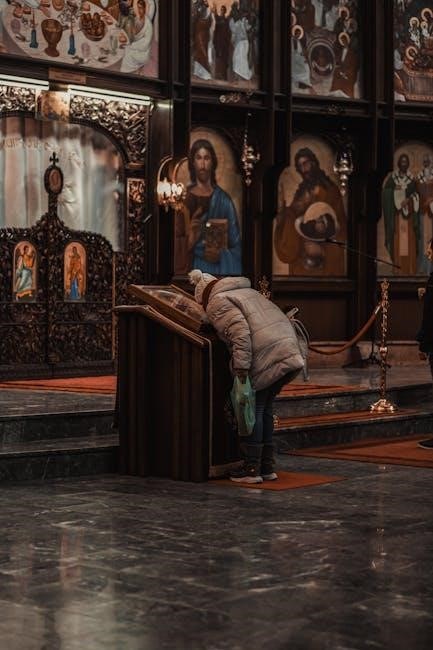
3.2 Theological and Religious Art
Theological and religious art heavily relies on iconography to convey spiritual themes and doctrines. Icons‚ such as those in Byzantine tradition‚ serve as visual representations of divine truths‚ bridging the earthly and heavenly realms. Religious iconography often uses standardized symbols and motifs to depict sacred narratives‚ making them instantly recognizable to adherents. For instance‚ the crucifix in Christianity or the Buddha’s mudras in Buddhism carry profound theological meanings. This art form not only inspires devotion but also educates communities about their faith. By examining these images‚ scholars can uncover the intersection of theology and culture‚ revealing how religious beliefs are visually expressed and preserved across generations.
3.3 Cartography and Iconography
Cartography and iconography intersect in the use of visual symbols to convey geographical and cultural information. Historical maps often incorporate iconographic elements‚ such as religious symbols or mythical creatures‚ to represent territories and ideologies. For instance‚ 18th-century cartography used imagery to denote political alliances or colonial claims. Iconography in maps serves both practical and ideological purposes‚ offering insights into the cultural and historical contexts of their creation. By analyzing these visual elements‚ scholars can uncover how cartographers communicated complex ideas about space‚ identity‚ and power. This fusion of art and geography provides a unique lens for understanding the interplay between visual representation and spatial knowledge.
3.4 Cultural and Social Studies
Cultural and social studies utilize iconography to explore how symbols and images reflect societal values and power dynamics. By examining visual motifs‚ researchers can uncover cultural identities‚ historical narratives‚ and social hierarchies. Iconography helps identify how different groups represent themselves and others‚ shedding light on inclusion‚ exclusion‚ and cultural exchange. It also reveals how visual language adapts over time‚ influenced by political‚ religious‚ and technological changes. This approach bridges art history and sociology‚ offering a deeper understanding of how imagery shapes and mirrors human experiences across diverse contexts and periods. Iconography thus becomes a powerful tool for analyzing the complexities of culture and society.
Interpretation and Analysis
Iconography involves interpreting symbols‚ themes‚ and cultural contexts to understand visual narratives. It requires analyzing historical and artistic elements to decipher meanings embedded in imagery.
4.1 Methodologies in Iconography
Iconography employs systematic methodologies to analyze visual symbols and themes. These include identifying motifs‚ contextualizing imagery within historical and cultural frameworks‚ and interpreting symbolic meanings. Scholars use hermeneutic approaches to uncover deeper significance‚ while comparative analysis traces iconographic evolution across periods and cultures. Interdisciplinary methods integrate art history‚ theology‚ and cultural studies to provide comprehensive insights. Digital tools now aid in cataloging and analyzing vast iconographic datasets. These methodologies ensure a rigorous and structured approach to understanding the complexities of visual representations in art and culture.
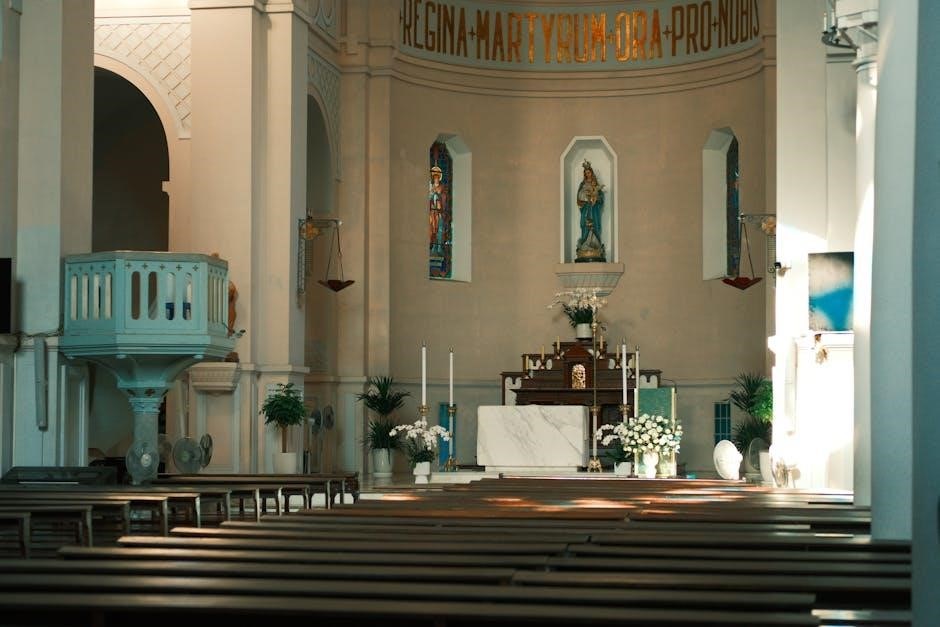
4.2 Challenges in Interpretation
Interpreting iconography presents challenges due to cultural and historical contexts‚ requiring deep understanding of symbolism and intent. Subjective interpretations can lead to varying meanings‚ and limited documentation complicates analysis. Iconographic symbols evolve‚ making their original intent obscure. Additionally‚ cultural bias and theological influences may skew interpretations. Digital tools aid analysis but require careful use to avoid misinterpretation. These challenges highlight the need for rigorous methodologies and interdisciplinary approaches to uncover accurate meanings behind visual representations.
Contemporary Applications
Iconography is used in digital media‚ education‚ and cultural preservation‚ providing insights into historical and contemporary societies through visual symbolism and interdisciplinary approaches.
5.1 Digital Media and Iconography
Digital media has revolutionized the study and application of iconography‚ enabling global access to visual archives and analytical tools. Platforms like digital databases and software facilitate detailed examinations of symbols and motifs across cultures and time.
Virtual exhibitions and social media expand the reach of iconographic imagery‚ fostering engagement and reinterpretation. Digital art and NFTs further integrate iconography into contemporary creative practices‚ blending tradition with innovation. These tools enhance accessibility and interdisciplinary collaboration‚ ensuring iconography remains a vibrant field in the digital age.
5.2 Educational Uses
Iconography serves as a valuable educational tool‚ enabling students to analyze and interpret visual symbols across cultures and historical periods. It is widely used in art history‚ theology‚ and cultural studies to teach critical thinking and visual literacy. Educational resources‚ such as PDFs and academic publications‚ provide comprehensive analyses of iconographic themes‚ aiding curriculum development. For instance‚ Gérard Colas’s work on ancient imagery and Kathleen Birney’s studies on funerary art offer insights for classroom instruction. Digital platforms also enhance learning by providing interactive access to iconographic collections‚ fostering deeper engagement with visual narratives.
By integrating iconography into education‚ students gain a nuanced understanding of cultural and historical contexts‚ preparing them to interpret and appreciate the richness of visual traditions.
5.3 Conservation and Restoration
Iconography plays a crucial role in the conservation and restoration of cultural heritage‚ providing insights into the historical and symbolic significance of artworks. Conservators use iconographic analysis to identify original intent‚ ensuring restorations align with artistic and cultural contexts. For instance‚ Byzantine art restoration relies heavily on understanding theological imagery‚ while Buddhist iconography guides the preservation of deity representations. Digital tools now aid in documenting and restoring iconographic details‚ enhancing accuracy and accessibility. These efforts ensure that iconic symbols endure‚ maintaining their cultural and historical value for future generations.

Notable Scholars and Contributions
Gérard Colas‚ Kathleen Birney‚ and Brian R. Doak pioneered iconography in ancient‚ funerary‚ and cultural studies.
Their work laid the foundation for modern iconographic analysis.
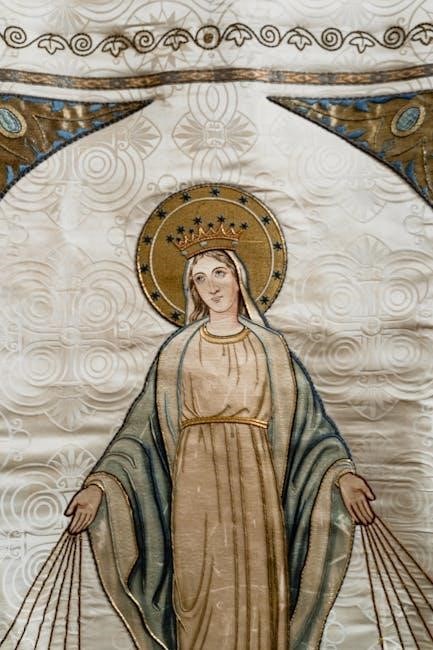
6.1 Gérard Colas and Iconography
Gérard Colas‚ a renowned scholar at the French National Centre for Scientific Research‚ has significantly contributed to the field of iconography. His work‚ particularly the 2010 publication Iconography and Images. Ancient Concepts‚ explores the intersection of imagery and cultural studies. Colas’s research delves into the themes and motifs in ancient art‚ providing a deeper understanding of their historical and cultural contexts. His methodologies have influenced modern iconographic analysis‚ blending art history with cultural and religious studies. Colas’s contributions are pivotal in bridging the gap between visual symbols and their meanings‚ offering a comprehensive framework for interpreting ancient and modern iconography. His work remains a cornerstone in the field‚ inspiring further research and academic discourse.
6.2 Kathleen Birney and Funerary Art
Kathleen Birney is a prominent scholar known for her contributions to the study of funerary iconography‚ particularly in ancient contexts. Her work‚ co-authored with Brian R. Doak‚ includes the paper Funerary Iconography on an Infant Burial Jar from Ashkelon‚ Israel‚ published in the Israel Exploration Journal (Vol. 61‚ No. 1‚ 2011). This research examines the symbolic motifs and imagery found on burial artifacts‚ shedding light on cultural and religious beliefs surrounding death. Birney’s analysis focuses on identifying and interpreting visual elements‚ providing insights into the funerary practices and societal values of ancient civilizations. Her methodologies in iconographical analysis have enriched the understanding of funerary art‚ linking visual symbols to their broader cultural and historical contexts.
6.3 Brian R. Doak and Cultural Iconography
Brian R. Doak is a notable scholar whose work bridges iconography with cultural and historical studies. His research focuses on the symbolic representation of cultural identities through imagery and motifs. Doak’s studies often explore how iconography reflects societal values and religious beliefs‚ providing a deeper understanding of cultural narratives. His methodologies emphasize the interpretation of visual symbols within their historical contexts‚ making his contributions invaluable to the field of cultural iconography. Doak’s work highlights the interconnectedness of art‚ culture‚ and history‚ offering fresh perspectives on how icons shape and mirror cultural evolution.
Case Studies
Exploring iconic imagery in Byzantine art‚ Buddhist deities‚ and Lenin’s political iconography reveals cultural and historical insights through symbolic representations and their societal impacts.
7.1 Byzantine Art and Theology
Byzantine iconography is deeply intertwined with theology‚ where art serves as a visual expression of religious doctrines. Icons‚ mosaics‚ and frescoes depict sacred narratives‚ emphasizing spirituality and divine presence. The use of gold backgrounds symbolizes the heavenly realm‚ while specific colors and compositions convey theological themes. This art form bridges the material and spiritual worlds‚ creating a transcendent experience for the viewer. The imagery is not merely decorative but a powerful tool for worship and theological communication‚ reflecting the Byzantine belief in the interconnection of art and faith.
7.2 Buddhist Deities and Symbolism
Buddhist iconography is rich with symbolic representations of deities and their attributes‚ conveying spiritual and philosophical concepts. The imagery often includes figures like Buddha‚ bodhisattvas‚ and protective deities‚ each with specific emblems. For instance‚ Buddha is depicted with the wheel of dharma‚ symbolizing his teachings‚ while Vajrapani holds the vajra‚ representing indestructible wisdom. Lotus flowers‚ wheels‚ and mandalas are recurring motifs‚ signifying enlightenment‚ cosmic order‚ and the path to liberation. These symbols are not merely decorative but serve as tools for meditation and understanding complex doctrines‚ bridging the physical and metaphysical realms in Buddhist art and practice.
7.3 Lenin’s Iconography in USSR
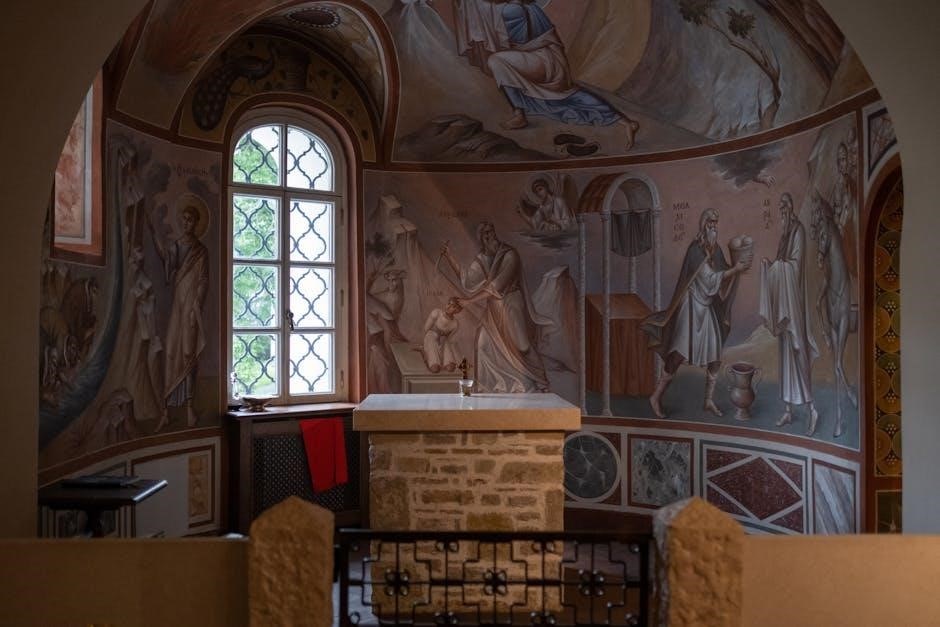
Lenin’s iconography in the USSR was a powerful tool for propagating communist ideology‚ depicting him as a revolutionary leader and symbol of proletarian struggle. His image appeared in various forms of media‚ from posters to sculptures‚ emphasizing his role as the founder of the Soviet state. Lenin was often portrayed with determined expressions‚ symbolizing strength and wisdom‚ while his gestures and attire were designed to convey approachability and connection to the working class. The iconography served to unify the population under communist ideals‚ legitimizing the regime and inspiring loyalty. Even after Stalin’s rise‚ Lenin’s imagery endured‚ becoming a cornerstone of Soviet visual culture and a lasting representation of revolutionary spirit.
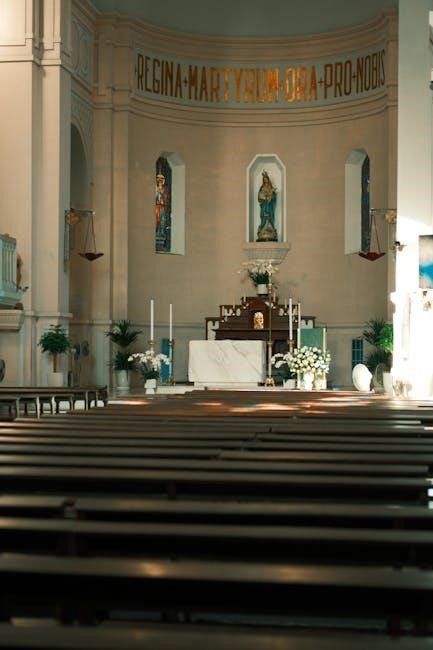
Resources for Further Study
Explore iconography through recommended PDFs like “A History of Art” by Germain Bazin and “Iconography and Images” by Gérard Colas for deeper insights into visual symbolism.
8.1 Recommended PDFs and Publications
For in-depth exploration‚ key PDFs include A History of Art by Germain Bazin and Iconography and Images by Gérard Colas. These works provide comprehensive insights into visual symbolism‚ historical contexts‚ and theoretical frameworks. Bazin’s book covers art from prehistoric times to the present‚ while Colas focuses on ancient concepts and their modern interpretations. Additional resources like Studies in Iconography from Princeton University offer innovative research on iconographic themes. These publications are essential for researchers and enthusiasts‚ offering detailed analyses of motifs‚ styles‚ and cultural influences in art and religion. They serve as foundational texts for understanding iconography’s role in shaping artistic and cultural narratives.
8.2 Key Journals and Research
Notable journals like Studies in Iconography and Index of Christian Art provide cutting-edge research on iconography. These publications explore themes‚ symbols‚ and cultural contexts‚ offering insights into art history and theology. Research by scholars such as Gérard Colas and Kathleen Birney highlights the evolution of iconographic motifs across religions and civilizations. Journals often focus on specific areas‚ like Byzantine or Buddhist iconography‚ detailing their historical and symbolic significance. These resources are invaluable for scholars and enthusiasts‚ bridging the gap between theoretical analysis and practical applications. They also address contemporary interpretations of ancient iconography‚ ensuring its relevance in modern academic and cultural discourse.
Iconography‚ as explored in this article‚ serves as a bridge between art‚ history‚ and culture‚ offering profound insights into societal values and beliefs. By analyzing imagery and themes‚ iconography reveals the symbolic language of past and present civilizations. Its interdisciplinary nature allows for a comprehensive understanding of cultural and religious expressions. The study of iconography continues to evolve‚ embracing digital media and new methodologies. As a field‚ it remains vital for preserving and interpreting visual heritage‚ ensuring that the stories and symbols of humanity endure. This conclusion underscores the enduring relevance of iconography in both academic and cultural contexts‚ highlighting its role in connecting the past to the present.
